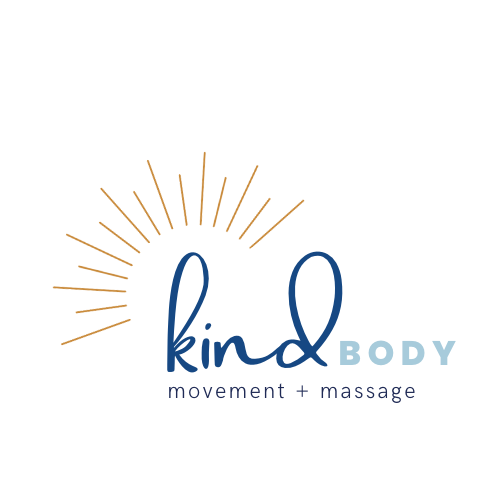Tight Muscle Tips
What to do when stretching doesn’t help.
Sometimes I link to products I love. As an Amazon Associate, I earn a commission from qualifying purchases.
After a few hours of computer work, my neck and shoulder muscles start to feel terrible. It’s this tight, tense feeling that doesn’t go away no matter how I stretch.
Have you experienced this before?
Maybe it wasn’t in your neck or upper back; maybe it was your hips or your lower back.
Clients come to me all the time saying, “My _____ feels so tight and stretching doesn’t seem to help.”
So what’s the deal with your tight muscles?
In today’s post, I’m going to share what exactly a tight muscle is, why it might be that way, and what you can do about it!
Move Your Mind
It’s time to shift your perception of your “tight” muscles.
“Tight” is an imprecise term because a feeling of “tightness” is totally subjective. This feeling of a muscle being tight may lead you to believe there’s a deficit in your range of motion or that your muscle is “too short.”
That’s usually not the case!
Why do my muscles feel tight?
You could be feeling that sensation of muscle tightness for a variety of reasons. Muscle “tightness” may have to do with…
Soreness during or after exercise
Staying in one position for too long
Unhelpful stress or tension
Overuse injury
Autoimmune disease
Hypermobility syndrome
Anxiety disorder
Or something else!
For some folks, that tightness may actually be a feeling of weakness. We often associate “tight” muscles with “toned” muscles and that’s not accurate. Just because a muscle feels “tight” doesn’t mean it is strong.
In situations where your “tight feeling” muscles are also your more underused muscles, consider reframing that feeling of tightness as “movement hunger.”
If a muscles is “tight,” I should stretch it, right?
Stretching might be your first response to that sensation of tightness. It can definitely help relieve that feeling for some folks.
If that works for you, great! Keep on keepin’ on.
For other folks (including those with hypermobility disorders), however, this probably won’t help much.
Folks with hypermobility disorders usually have joint laxity. Although they can appear super flexible, they may still experience the sensation of muscle tightness. That’s typically because the load of their movements skips right over their muscles and goes straight to their unstable joints.
If you’ve tried stretching your tight muscles to no avail, try this instead.
Therapy balls are great for adding pressure to “tight” muscles. ©KindBody Movement, LLC 2021
2 Tips for Your Tight Muscles
1. Add pressure.
Grab a therapy ball, dowel, yoga block, or a massage therapist and add pressure to the “tight” area. Be sure to find that Goldilocks amount of pressure that’s “just right” for you. Avoid pressure that makes you tense, clench, or hold your breath.
While holding that pressure, try moving the associated joints. Take slow, deep breaths to calm your nervous system.
Why it works: The pressure you provide to your “tight” spot is a new sensation for your nervous system. Essentially, that novel experience can “reset” your system’s alarm bells of discomfort and tightness.
Other things that might work: Apply moist heat either with a heating pad or a warm bath. Give your bath a boost with muscle-soothing Epsom salts. Be sure to follow the directions on the bag to get the right concentration.
2. Move it and use it.
Now get that “tight” spot moving. Move the associated joints through their full range of motion.
Don’t be afraid to move the joint in the direction of the tightness. For example, if your shoulders are feeling tight (the space where tank top straps rest), don’t just move your shoulder joint away from your ear. Give the muscle some “slack” by moving your shoulder in the direction of the tightness, towards your ear.
Have you ever had a dresser drawer jam? You can tug and tug to try to get it loose but the only thing that works is to push the drawer back in a bit so it can reset before pulling it back out.
Similarly, if you hold a rubber band totally stretched out, it feels tight. You wouldn’t continue stretching one end of the rubber band away from the other to reduce that tight feeling. You would move the ends closer together to allow the rubber band to soften with the slack.
In fact, avoid holding the muscle in one position for too long after you’ve applied the pressure from step 1. Simply use your muscular control to move your body.
Why it works: Remember that oftentimes “tight” muscles are actually “movement starved” muscles. One of my favorite bodyworker phrases is “motion is lotion.” Keeping those “tight” spots moving allows your tissues to stay hydrated and healthy.
Despite having the knowledge of these two steps, it can be hard to figure out exactly how to implement them for specific parts of your body. Here’s two tight muscle remedies for common areas of discomfort.
This picture shows an upper trapezius massage. ©KindBody Movement, LLC 2021
Tight Muscle Remedy #1 - Neck/shoulders
This tight muscle remedy focuses on the upper trapezius muscles (where your tank top straps rest).
Step 1: Apply pressure
Grab a therapy ball and head to a door frame. Pin the ball between your tight spot and the door frame. As you hold that pressure, gently move your head to one side (ear to shoulder) and look to one side (rotate). In addition, explore arm and shoulder movements such as a shoulder shrug (this will increase the feeling of pressure from the ball so you don’t need to shrug too hard).
You can see a quick demo of this here.
Step 2: Move it + use it
After you release the pressure from the ball and get upright once more, do some shoulder circles to get your shoulder blades moving along your back. As you circle your shoulders, resist yourself a bit so it feels like you’re moving through cold honey. Remember to go in both directions.
Additionally, you could drop to hands and knees for some scapular retraction pushups. (Keeping straight arms and neutral spine, squeeze the shoulder blades toward one another any amount. Then, push through your hands and feel how the shoulder blades move away from one another. Incrementally add to your push so you eke out all the movement you can.)
Self-massage for tight hips. ©KindBody Movement, LLC 2021
Tight Muscle Remedy #2 - Hips
This tight muscle remedy focuses on the fronts of the hips, where your front thigh meets your pelvis.
Step 1: Apply pressure
Grab two therapy balls or a foam roller. Lie on your stomach with the balls or roller pinned just below your hip crease. After taking a few deep breaths, rock your hips from side to side. Lift one leg up at a time (try this with straight legs and also with bent knees).
Step 2: Move it + use it
After you release the pressure of the balls or foam roller, stand up. Use a wall or chair to help with balance if needed, and try some bent-knee hip circles. Move slowly and resist yourself as you go so it feels like you’re moving through cold honey. Be sure to explore the edges of your range of motion for each hip and go in both directions. (You could also try these hip circles in the all fours position.)
Additionally, you could add some glute bridges. (Lie down on your back with your knees bent. Press through your heels to lift your hips away from the ground and lower back down slowly, with control.)
Conclusion
The most important thing to remember is that tight muscles aren’t necessarily strong muscles and are frequently “movement starved” muscles.
If you suspect your experience of muscle tightness is tied to an autoimmune disease, anxiety disorder, or hypermobility syndrome, enlist the help of your doctor to make a treatment plan.
Otherwise, add pressure (and maybe some heat) and get moving!









